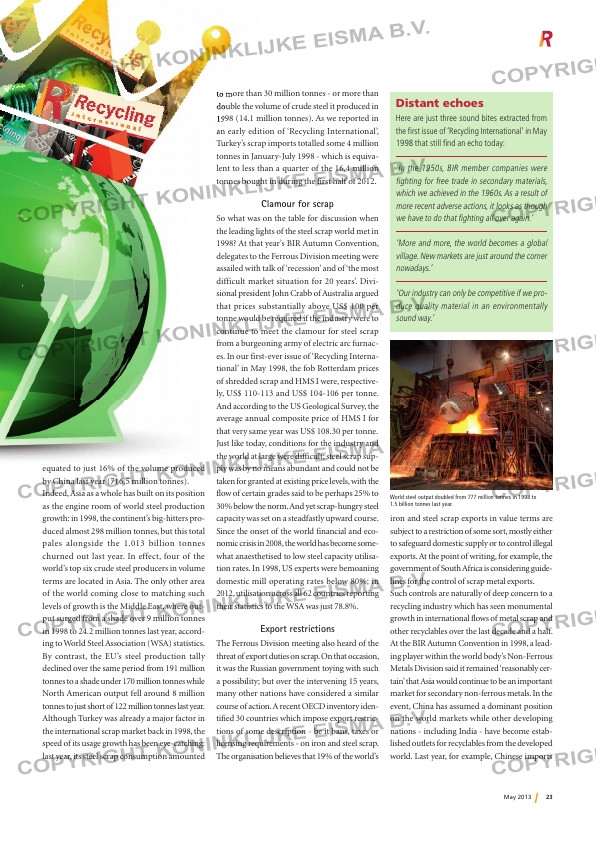Page 23 from: May 2013

23May 2013
equated to just 16% of the volume produced
by China last year (716.5 million tonnes).
Indeed, Asia as a whole has built on its position
as the engine room of world steel production
growth: in 1998, the continent’s big-hitters pro-
duced almost 298 million tonnes, but this total
pales alongside the 1.013 billion tonnes
churned out last year. In effect, four of the
world’s top six crude steel producers in volume
terms are located in Asia. The only other area
of the world coming close to matching such
levels of growth is the Middle East, where out-
put surged from a shade over 9 million tonnes
in 1998 to 24.2 million tonnes last year, accord-
ing to World Steel Association (WSA) statistics.
By contrast, the EU’s steel production tally
declined over the same period from 191 million
tonnes to a shade under 170 million tonnes while
North American output fell around 8 million
tonnes to just short of 122 million tonnes last year.
Although Turkey was already a major factor in
the international scrap market back in 1998, the
speed of its usage growth has been eye-catching:
last year, its steel scrap consumption amounted
to more than 30 million tonnes – or more than
double the volume of crude steel it produced in
1998 (14.1 million tonnes). As we reported in
an early edition of ‘Recycling International’,
Turkey’s scrap imports totalled some 4 million
tonnes in January-July 1998 – which is equiva-
lent to less than a quarter of the 16.4 million
tonnes bought in during the first half of 2012.
Clamour for scrap
So what was on the table for discussion when
the leading lights of the steel scrap world met in
1998? At that year’s BIR Autumn Convention,
delegates to the Ferrous Division meeting were
assailed with talk of ‘recession’ and of ‘the most
difficult market situation for 20 years’. Divi-
sional president John Crabb of Australia argued
that prices substantially above US$ 100 per
tonne would be required if the industry were to
continue to meet the clamour for steel scrap
from a burgeoning army of electric arc furnac-
es. In our first-ever issue of ‘Recycling Interna-
tional’ in May 1998, the fob Rotterdam prices
of shredded scrap and HMS I were, respective-
ly, US$ 110-113 and US$ 104-106 per tonne.
And according to the US Geological Survey, the
average annual composite price of HMS I for
that very same year was US$ 108.30 per tonne.
Just like today, conditions for the industry and
the world at large were difficult; steel scrap sup-
ply was by no means abundant and could not be
taken for granted at existing price levels, with the
flow of certain grades said to be perhaps 25% to
30% below the norm. And yet scrap-hungry steel
capacity was set on a steadfastly upward course.
Since the onset of the world financial and eco-
nomic crisis in 2008, the world has become some-
what anaesthetised to low steel capacity utilisa-
tion rates. In 1998, US experts were bemoaning
domestic mill operating rates below 80%; in
2012, utilisation across all 62 countries reporting
their statistics to the WSA was just 78.8%.
Export restrictions
The Ferrous Division meeting also heard of the
threat of export duties on scrap. On that occasion,
it was the Russian government toying with such
a possibility; but over the intervening 15 years,
many other nations have considered a similar
course of action. A recent OECD inventory iden-
tified 30 countries which impose export restric-
tions of some description – be it bans, taxes or
licensing requirements – on iron and steel scrap.
The organisation believes that 19% of the world’s
iron and steel scrap exports in value terms are
subject to a restriction of some sort, mostly either
to safeguard domestic supply or to control illegal
exports. At the point of writing, for example, the
government of South Africa is considering guide-
lines for the control of scrap metal exports.
Such controls are naturally of deep concern to a
recycling industry which has seen monumental
growth in international flows of metal scrap and
other recyclables over the last decade and a half.
At the BIR Autumn Convention in 1998, a lead-
ing player within the world body’s Non-Ferrous
Metals Division said it remained ‘reasonably cer-
tain’ that Asia would continue to be an important
market for secondary non-ferrous metals. In the
event, China has assumed a dominant position
on the world markets while other developing
nations – including India – have become estab-
lished outlets for recyclables from the developed
world. Last year, for example, Chinese imports
Distant echoes
Here are just three sound bites extracted from
the fi rst issue of ‘Recycling International’ in May
1998 that still fi nd an echo today:
‘In the 1950s, BIR member companies were
fi ghting for free trade in secondary materials,
which we achieved in the 1960s. As a result of
more recent adverse actions, it looks as though
we have to do that fi ghting all over again.’
‘More and more, the world becomes a global
village. New markets are just around the corner
nowadays.’
‘Our industry can only be competitive if we pro-
duce quality material in an environmentally
sound way.’
World steel output doubled from 777 million tonnes in 1998 to
1.5 billion tonnes last year.
RI-4_Looking Back.indd 23 03-05-13 14:01



